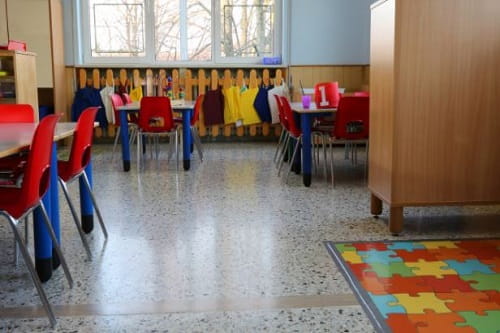What Is A Self-Contained Classroom?

Let’s first start off by defining what full inclusion means. Full inclusion means that a student will be placed in a classroom with typical peers (25-30 students) for the entirety of the school day. A self-contained classroom is pretty much the opposite of full inclusion.
A self-contained classroom refers to a classroom that is characterized by; a smaller setting, lower student/teacher ratio (usually 10 students or less), taught by a certified special education teacher, and has a paraprofessional or instructional assistant for additional support. In a self-contained classroom, the special education teacher ensures that the student is receiving the accommodations necessary (as listed in his/her IEP) for them to access the general education curriculum. These specific needs and additional requirements may be best implemented in a smaller setting and with more support, in order to help students with their academic needs.
Some students are enrolled in a self-contained classroom for 1 or more specific courses (English, Math, History, Science etc.) where they need additional support. This allows the special education teacher to modify curriculum, instruction, and materials so that the student can still access the general education curriculum. Students who are placed in a self-contained classroom for 1 or few classes may still be on track to receive a standard high school diploma. They just require additional supports for a specific class(es).
There are other students who are placed in a self-contained classroom/setting for all instructional courses, where a special education teacher is responsible for instruction in all academic subjects. Students who are enrolled in the self-contained setting all day, may often be integrated into a general education setting for elective classes like physical education, art, music etc. These students may be on track to receive some type of modified diploma.
Most students who have moderate to severe developmental/cognitive disabilities, severe behavioral or emotional issues, and function significantly below grade level are in self-contained classrooms 100% of the time. They are also most likely on an adapted curriculum (as set by state standards) and will receive a special education diploma. They most likely take part in adapted physical education or other adapted electives, which means they do not participate with general education students for any of their classes. While they are in the self-contained setting most of the time, it’s important that whenever possible, these students are able to be integrated with general education students, i.e. cafeteria for lunch, assemblies, hallways for transition etc. We want to remember the importance of these peer interactions and give our students as many opportunities as possible to develop other types of friendship/interactions. If your school has an opportunity to have peer helpers or special programs/clubs that can foster these types of relationships, go for it!
Why is it beneficial to have self-contained classrooms?
Self-contained classrooms enable teachers to work with students on specific interventions, strategies, and skills that may not be addressed in a general setting. Some of these areas are– life sills, basic skills, behavioral goals/strategies, coping skills, executive functioning etc. Smaller settings allow special education teachers to accommodate and cater to the diverse needs of each student. The lower student/teacher ratio and addition of a paraprofessional, allow the student to receive more support and one-on-one attention. For students who require a completely adapted curriculum, the self-contained classroom provides a more appropriate setting for their academic instruction. The special education teacher can modify lessons, activities, and materials to ensure that all students are receiving instruction at their cognitive level.
Being placed in the appropriate setting also ensures that students are receiving all the tools they need to foster academic success.
Should your child/student be in a self-contained classroom?
The decision to enroll a student in self-contained classroom is an important one and should be taken seriously. Every opportunity to help that student succeed in the general education classroom (with supports) should be taken advantage of before switching a student’s classroom setting for instruction. Make sure that everything that has been tried is documented in the IEP and that there is a clear reason why that student has been placed in this setting.
It’s also important to note that the student should be placed in their least restrictive environment (LRE). This is part of IDEA (Individuals with Disabilities Education Act), that says students should be placed with students who do not receive special education as much as possible. Students should receive instruction and learn in their least restrictive environment. This is a team decision that should be made at an IEP meeting. It’s also important to make sure that parents understand what this means for their child, the classes they will take, what their school day will look like, accommodations they will receive in class and in testing environments, and what type of diploma they will receive when they graduate from high school.
When everyone on the team is on the same page about a child’s academic placement, strengths/needs, and short and long term goals (academic & life), being able to help provide the student with the tools they need for success is much easier!
